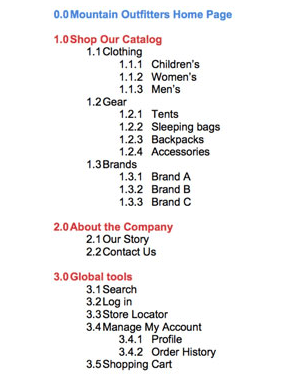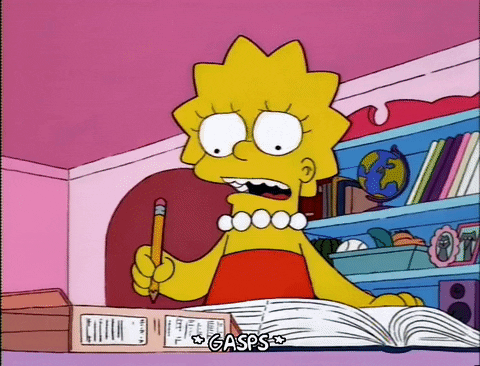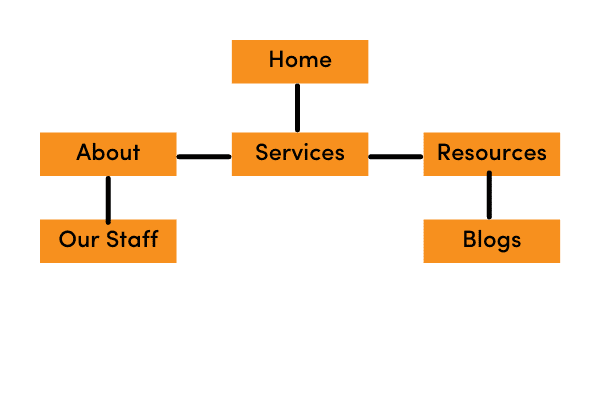What is a Web Content Outline? Plus a Sample

Are you ever working on creating a custom website and get completely lost? Unsure of where to put your important content and how your pages should flow to create an effortless user experience?
The best way to create a website that attracts and converts your audience is by starting with a detailed web content outline.
In this guide, I’ll show you the ins and outs of a great web content outline, plus I’ll even give you some examples.
What Is A Web Content Outline?

When it comes to defining what a web content outline is, you can think of it as a detailed version of your sitemap. It will list out all the different types of content sections and functionality you want on your website page by page or by each unique page template.
Examples of this would include a page template for your homepage, case study page, or blog page.
In a more clear way, a content outline simply lists each section of content and hierarchy structure you want to convey per page. These should be the information and pages that your users are looking for when they come to your website.
Importance of Web Content Outline in a Web Development Process
While there are many reasons a web content outline is important for the web development process, the following are of particular importance and worth taking note of.
1. Stay On Schedule
Rolling out a new website can be stressful. There are so many parts that are moving during the development process that it’s easy to fall behind in your website development and release schedule.

By using a content outline, you can stay on top of the schedule. Experts in the field say that content delays are the top reasons a project might fall behind.
Instead of delaying your website’s design further, use a web content outline.
2. Speed Up Your Content Writing Process
By creating a web content outline, you are structuring your website around the content from the get-go.
Doing this forces you to think about your content from the very beginning of your website design process. With your mind already in the content mode, creating your website content is far easier and much faster.

Think about how much time you spend thinking of the content for your website normally. Imagine how much faster you could write it if you already know what content is going on your website and where during the design process?
That means as soon as your website design is complete, you can simply plug in the content you’ve written.
3. Reduce Number of Revisions

Crafting a website is done with the assumption there will be some revisions along the way.
However, by creating an outline at the beginning of the process, you can reduce the number of revisions that you have to do. Your website design will be created around the structure of your content, so you won’t have to go back and change either facet of your website nearly as much.
One of the key parts of creating a great web content outline is thinking about the usability of your website’s design and structure. By formatting your website around the data that you have regarding your users, you can write an outline that leads to a highly functional and enjoyable website for your users.
The longer you can get them to stick around on your website, the more likely they will be to increase their views on your website or buy what you’re selling.
General Guidelines in Developing a Web Content Outline
Creating a web content outline doesn’t have to be a stressful experience. With these general guidelines, creating your outline will be an easy, exciting time in your website development process.
1. Brainstorm
To start out, you need ideas. One of the best ways to gather your ideas in an ordered, easy-to-manage way is to have a solid brainstorming session.

Look at your competitor’s websites and see how they have their content written per page. What content is available above the fold and what content is below the fold. Check what other functionality they might have that you think your audience will be engaged with.
2. Organize Ideas
Once you’ve brainstormed and identified the ideas that match with the areas of your website, you’ll need to better organize your ideas so they make sense on the page.
Group your ideas into categories and subcategories. These are going to be your landing pages when your website design is completed. By doing this, you’ll bring a logical approach to your outline.
3. Create a Website Sitemap
Now that you have your ideas and they are organized, it’s time to draft your sitemap.
A sitemap is simply all the pages that your website will have (ie. homepage, about page, product page, service page, contact us page). It should show how the pages are organized and on how many levels. As tempting as it can be to get complex, try to keep it to three levels unless a more complicated sitemap is required.
You might be wondering why creating a sitemap is important. The reason is that it reinforces the purpose of your website. As you keep your purpose in mind, you will build a more clear path to creating an effective website.
Here is an example of a sitemap:

3. Base It On Data
In creating an outline, you’ll be pulling ideas from all over. A practice you should adopt is to base your final decisions on data. That will keep things more focused in the areas where you’ll have the most success on the website.
This involves data about:
- Hot and cold areas
- Heat maps
- Clicks
- Events generation
- Page scrolling
4. Test A Couple Of Versions of Web Content Outlines
Once you have a web content outline written, you’re done, right?
No!
Now it’s time to start over and create another one.
Creating and testing two to three versions of your web content outline will help you to collect actionable data for your final website. Testing them will prove which is the most effective.
Examples of a Web Content Outline
The following are some examples of various web content outlines meant for a variety of websites:
Homepage
- Header with menu and logo
- Hero image with text and call to action (cta)
- Product Value Section
- Why the Production Content section
- Competitor Comparison Chart
- Feature Content Section
- Testimonials
- CTA Form
- and Footer
Blog Page
- Latest Posts
- Blog 1
- Blog 2
- Related Resources
- Form Section
- Footer
Create An Effective Web Content Outline
If you want an effective website, you need a web content outline. As this outlines the information on your website, it will be an excellent way to organize the ideas you have for your website and put them in logical order.
By using an outline, you’ll enjoy happier customers, higher conversion rates, and a content-first approach to your website design that will keep your design process on schedule.
With the examples provided and the guidelines about web content outline creation, your outline will nearly write itself.
Which guideline did you find most helpful? Let me know in the comment below!








